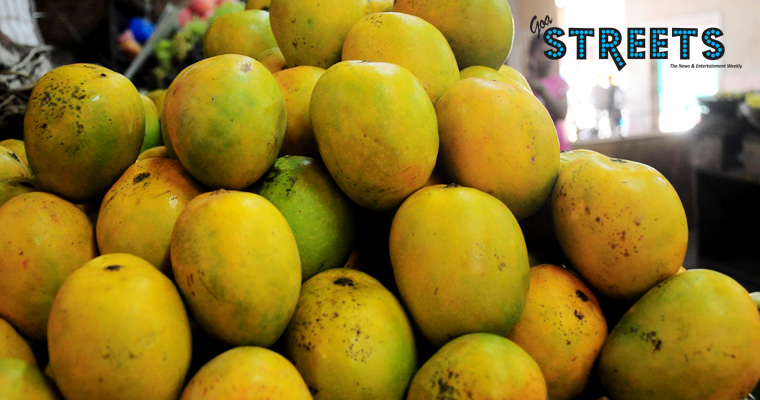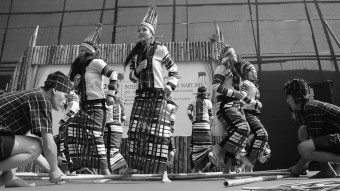‘
‘
Beware: Unscrupulous vendors hawk fakes
The King of Fruits sits on a plate before you. As your knife sinks into the pulp, you are drooling, but you scoop some into your mouth and your taste buds sound an alarm. Is it really the King on your plate, or an imposter? The topnotch mancurad mango you bought at the market could well be a lookalike variety, palmed off to you by unscrupulous vendors.
As all mango lovers know, there’s something deeply disappointing about biting into a mango that fails to live up to its promise.
Selecting the right mango to eat has long been a Goan obsession. Back when there were no markets, the norm was to grow your own mangos. Usually people would plant the seed of a mango which they had eaten and liked. Or they would ask the owner of the tree, which had yielded a succulent mango, for a ‘graft’ of that specific variety, which they would then plant in their yard.
.
A housewife makes a bargain overearly season mangoes at the Panjim Municipal Market.
And then they would watch the tree grow. A few years later, the first mangoes would appear. At times they would be as good as the fruit of origin. Or perhaps even better. More often, they were a little worse, in which case they would graft a branch of the new tree with another branch of a different tree and plant the resultant graft, and maybe get a great tasting mango at some point in the long process.
All this explains the bewildering variety of mangos now available in Goa. With the markets here, only a few diehards bother to grow their own mango trees anymore. Call it instant gratification, Goan-style. Why wait years to eat a good mango?
But do you really know what mango you’re eating? Is it really a premium-quality ‘mancurad’ which has been sold to you? Chances are that when you go to a market these days, the vendor will try to convince you that his mangos are ‘mancurads’, the magic variety most desire, even though his may be a different type altogether. More than 77 mango varieties have been recorded in Goa, incluing a large variety of ‘mancurads’ too. The Bardez version is slightly different from the Salcete kind and so on.
In recent years, scientists at the Indian Council for Agricultural Research (ICAR) station at Old Goa have worked to develop a standard ‘mancurad’ plant, which has then been widely disbursed to Goan growers. The idea is to create the perfect mango of this variety, which could then be grown by farmers in large quantities and exported. “We have collected different ‘mancurad’ types from all over: Siolim, Madkai, South Goa, Bicholim, etc, and planted them in our farm for comparison,” says Dr AR Desai, senior research scientist at ICAR, who has been studying mangos for decades.
.
Fruits sellers display the prized Mancurad mango at the Panjim Municipal market
During his research, he discovered that the famous Ratnagiri ‘hapus’ (aphonso) mangos are actually derived from Goan ‘mancurads’. In neighbouring Maharashtra they have standardized the ‘aphonso’ and grown this variety on a large scale. When these mangoes are harvested they can be packed and exported, because most of them are of the same size, colour and taste. Which is not the case with Goan ‘mancurads’, which though similar, differ in size, colour and taste from one orchard to another, though they’re all arguably ‘mancurads’.
“Everybody who comes here asks for ‘mancurad’ only,” says Sanjeev Mayekar, the Bardez Zonal Agricultural Officer, about people taking saplings to plant in their properties. Yes, there are still people who follow the old Goan tradition of planting a mango tree on their property.
While they buy the right plant, they don’t really know what to do next, says Mayekar. “A lot of the people are not planting in ideal conditions,” he says. “Most people plant either in the front or back yard which also have flower and other trees on account of which they irrigate the area all the time, which is not good for mango trees,” he says.
So the ‘mancurad’ tree does not grow properly, and though it does give fruit, it’s not quite the fruit which would have been given in ideal conditions. “There are a lot of things,” says Mayekar. “You have to do precision farming. The trees need a lot of sunlight and should be planted at least 15 meters apart. You should water them only during the summer months of the first three years, after which they should get water only during the monsoon. After harvest they should get water and manure, so that you get flowering for the next season,” he says, explaining the many factors which go into good mangos.
.
A mango plucker at work
Ratnakar is a mango trader in Candolim who plucks the mangos from trees and sells them to retail vendors. As his workers climb a huge mango tree, he says, “This variety actually has no name. It’s like a ‘malgesh’, but it is a cross-breed. Today people don’t take care of their trees like in the old days, so the quality of the mangos is also not very good. We don’t sell directly, but to the vendors who then tell the customers whatever name they fancy. Today people don’t know anything. What they want to know is how many mangos they can get for 100 rupees, the more and bigger the better,” he says.
There are mango varieties which are large and sweet and could also pass off as ‘aphonso’ or ‘mancurad’ or ‘hilario’, the other variety which is hugely popular with Goans. Being an agricultural researcher himself, Mayekar has grown a variety called ‘ratna’ in his property at Bicholim. “It’s good. It’s big. It’s a cross between ‘aphonso’ and ‘neelam. It gets most of its character from ‘aphonso’, but grows late in the season like ‘neelam’ and also has a long shelf life,” he says.
A true mango connoisseur, however, will always be able to tell the difference between these varieties and an authentic mancurad, aphonso or hilario. These newbies may be decent enough, but still have a hard time matching the depth of flavor of the elites.
In earlier years, mangos were grown for different purposes. To eat as a table fruit, for trade, for making jams and squashes, for making pickles, to be dried and used as a spice in food and so on. So what is good for the table was not good for the pickle, and so on. In this way the ‘monserrate’ (or ‘musrad’ as it is locally called) variety is used for making jams, while pickles are made from the ‘karel’ variety of mango.
According to Dr AR Desai, while Goa was a hotspot for developing mango varieties during the Portuguese era, it is somewhat lagging behind in exploiting this natural advantage when it comes to exporting mangos to lucrative markets in Europe and West Asia.
“We tried exporting with the Department of Agriculture and the Goa government a few years ago. A consignment of ‘mancurads’ was sent to Europe, but there were no repeat orders because of a simple problem: All the mangoes were not the same,” Dr Desai explains.
“Because we needed a large quantity, we sourced the best ‘mancurads’ from orchards all over Goa, but though they were all ‘mancurads’, they differed slightly in skin colour, in size and also taste. So the buyers in Europe were not convinced they were the same mangos. I feel the Goan government should set up a mango development council to propagate scientific planting of a good ‘mancurad’ variety so that mangos of a standard quality are produced on a large scale which could then be exported. It has been done in Maharashtra with the Ratnagiri ‘aphonso’,” he says.
It’s not uncommon on Goan Streets to see vendors with baskets full of luscious, juicy mangos. Stop and ask them what type they are, and pat will come the reply “Mancurad”! To be fair, though, there are also many vendors who are honest enough to tell you it’s a ‘malgesh’ or a ‘monserrate’. Besides which there are many buyers who know their ‘mancurad’ from a ‘hudgo’. So get yourself a few mangos and start learning. For starters, a ‘mancurad’ should be only yellow – there should not be even the slightest blush of orange or pink on its shoulders (which also explains the origin of the name mancurad, believed derived from the Portuguese ‘mal corada’, or poorly coloured). It should not be spongy inside. It should be fibrous just under the skin but no more, and it should be devilishly delicious.
.
.
.







